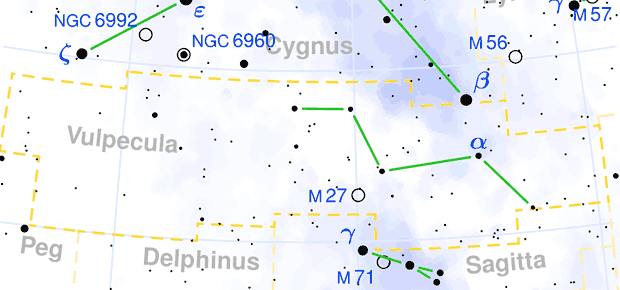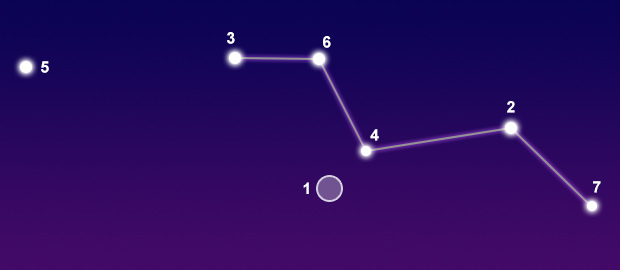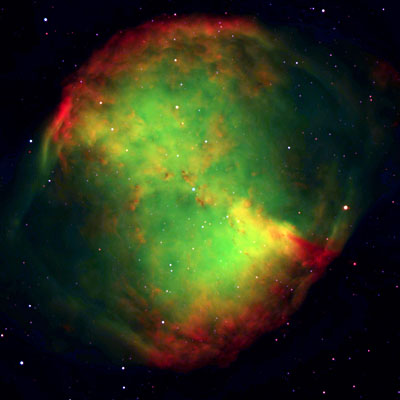Pronunciation:
(vul-PEK-u-luh)Abbreviation:
VulGenitive:
VulpeculaeRight Ascension:
20 hoursDeclination:
25 degreesArea in Square Degrees:
268Crosses Meridian:
9 PM, March 1Visible Between Latitudes:
90 and -55 degreesThe constellation Vulpecula, the fox, is located in the northern hemisphere of the sky. It is visible between latitudes 90 degrees and -55 degrees. It is a small constellation that occupies 268 square degrees of the sky. This ranks it 55th in size among the 88 constellations in the night sky. It is bordered by Cygnus, Delphinus, Hercules, Lyra, Pegasus and Sagitta. It can easily be found in the middle of the Summer Triangle, a triangular asterism formed by the bright stars Deneb in Cygnus, Vega in Lyra, and Altair in Aquila.
There are no myths associated with Vulpecula. Its name means “little fox” in Latin. It was introduced by the Polish astronomer Johannes Hevelius in the late 17th century. It was originally named Vulpecula Cum Ansere, "the little fox with the goose," and Vulpecula et Anser, "the little fox and the goose," and was illustrated with a goose in the jaws of a fox. The stars were later separated into two constellations, Anser and Vulpecula, and then later recombined under the name Vulpecula. Today, the goose is only remembered by the name of the star Anser.


Anser
23 Vulpeculae
13 Vulpeculae
31 Vulpeculae
15 Vulpeculae
1 Vulpeculae
"Goose"
N/A
N/A
N/A
N/A
N/A
Red Giant Star
Orange Giant Star
Blue Giant Star
Yellow Giant Star
White Giant Star
Blue Subgiant Star
4.40
4.52 4.57 4.59 4.66 4.77
Vulpecula is a very dim constellation with no stars brighter than magnitude 4. The brightest star is Anser with a visual magnitude of 4.40. It is a red giant star located about 297 light years from Earth. The second brightest star is 23 Vulpeculae with a magnitude of 4.52. It is an orange giant star located 328 light years from our solar system. The third brightest star is 13 Vulpeculae with a magnitude of 4.57. It is a blue giant star that lies approximately 335 light years away.
Vulpecula contains one Messier object, the famous Dumbbell Nebula. Known also as M27, it is a planetary nebula that gets its name from its hourglass shape, which resembles a dumbbell used for weight lifting. It was formed when an old star shed its outer layer of gas. It is sometimes also called the Apple Core Nebula and is located approximately 1,300 light years from Earth. There are a few other dim deep-sky objects in this constellation, but they can only be seen in very large telescopes.

© European Southern Observatory / CC BY 4.0



